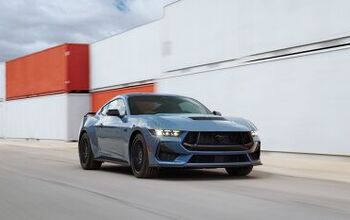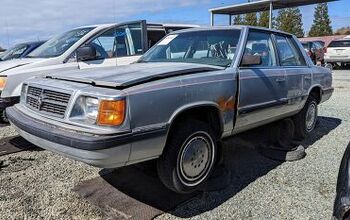17 Views
Vellum Venom Vignette: Innovation, Planned Obsolescence and Fisher Body

by
Sajeev Mehta
(IC: employee)
TTAC commentator Arthur Dailey writes:We all understand that developing a new vehicle requires hundreds of millions of dollars and a number of years. However between the early ’50s and late ’70s, the Detroit Three unveiled multiple “new” vehicles on an annual basis. I remember eagerly watching the first episode of Bonanza, each September through most of the ’60s because that’s when Chevrolet would unveil its new cars to the public.The split-window Corvette, the Corvair Monza, the Caprice and the Camaro, all seen for the first time on Sunday nights.
{
"id": "9025045",
"alt": "",
"title": "",
"video_link": "https://www.youtube.com/embed/l-7ZmsBXBOk",
"youtube_video_id": "l-7ZmsBXBOk"
}
{
"width": 634,
"height": 357,
"showRelated": true
}
That insightful quote comes 3:40 into this Fisher Body video. Depending on your perspective, you’re either a cynical believer in planned obsolescence or you’re an early adopter of the latest innovations. The former is well covered, the latter conjures buzzwords like synergy and enlightened organizational management; perhaps more than buzzwords, as this insightful fable regarding Fisher Body suggests.General Motors didn’t rise to the top because they were evil corporate bloodsuckers! (Perhaps that’s debatable.) GM innovated, continually refined it products, and added more brands to nurture said refinements (Pontiac for Performance, Cadillac for luxury, etc.) to appeal to all markets. Contrast GM’s innovation/planned obsolescence to Henry Ford’s begrudging and tardy admission of the Model T’s obsolescence. Too little, too late: GM and Fisher Body were primed for multi-level success, especially after World War II.GM and Fisher Body were innovators in style (we all know Harley Earl’s legacy), but also engineering. To wit, the following quote while Ford was churning out Model Ts:In 1920, Fisher made the first scientific use of insulation in an automobile to reduce noise and keep out heat and cold. It also narrowed the windshield pillars to provide increased vision. Fisher Bodies had the first dependable window regulator for closed cars. In 1923, Fisher Body made one of its most important contributions to the automobile world when it pioneered the use of lacquer instead of paint and varnish for bodies. This proved one of the greatest advantages in attaining volume production, helping to bring the closed car within reach of the average buyer. Instead of taking four weeks to paint and trim a body finished in varnish, it took six hours. Color became important in automobile styling.— Coachbuilt.comThis modus operandi demanded GM introduce cars significantly restyled and re-engineered almost every year. Ford and Chrysler had little choice but to follow suit, even if the changes were a mixed bag of relevance.This is much like how TTAC fans feel about today’s advancements! Consider your feelings about BMW’s first i-Drive or today’s hit-or-miss infotainment systems, from a snobby Toyota Prius body to a cheaty TDI Volkswagen engine, and from a Ford Fusion to a Lincoln MKZ. Perhaps we should thank Fisher body for today’s good and bad product introductions.Today’s changes come just as quickly, but now it’s concentrated on in-car technology. Not as memorable as your childhood watching Bonanza, but that TV show and Fisher Body ended for valid reasons.Innovation and planned obsolescence are here to stay — love it or leave it … or both. [Image: Shutterstock user Flystock]Send your queries to sajeev@thetruthaboutcars.com. Spare no details and ask for a speedy resolution if you’re in a hurry … but be realistic, and use your make/model specific forums instead of TTAC for more timely advice.

Sajeev Mehta
More by Sajeev Mehta
Published August 31st, 2016 12:00 PM
Latest Car Reviews
Read moreLatest Product Reviews
Read moreRecent Comments
- Bd2 If I were going to spend $ on a ticking time bomb, it wouldn't be for an LR4 (the least interesting of Land Rovers).
- Spectator Wild to me the US sent like $100B overseas for other peoples wars while we clammer over .1% of that money being used to promote EVs in our country.
- Spectator got a pic of that 27 inch screen? That sounds massive!
- MaintenanceCosts "And with ANY car, always budget for maintenance."The question is whether you have to budget a thousand bucks (or euro) a year, or a quarter of your income.
- FreedMike The NASCAR race was a dandy. That finish…


































Comments
Join the conversation
I'm thinking that video is a glimpse at the high-water mark of American manufacturing employment. Just imagine all the jobs represented by the production of merely the cabinetry and hardware of those primitive computers and sundry test gizmos.
Talking about Bonanza Chevy commercials there was one commercial where the Cartwright boys were standing around waving their guns. Papa Cartwright shows up and asks about the guns. Hoss replies that they were going 'bird hunting' they were after 'falcons and t-birds'. Can you imagine such a commercial being made today?